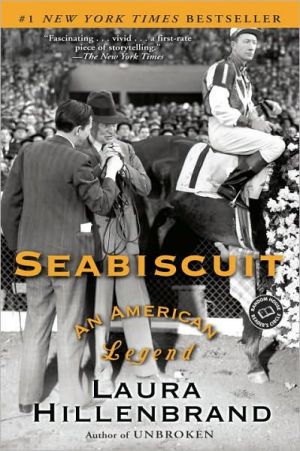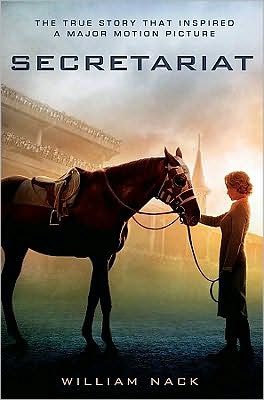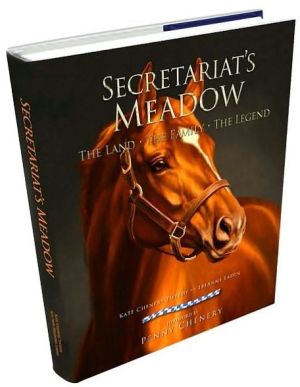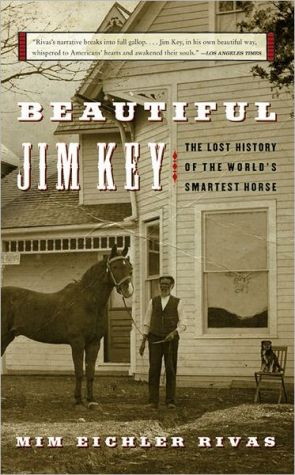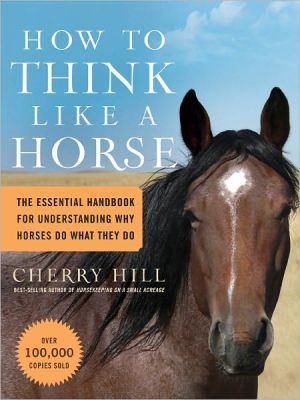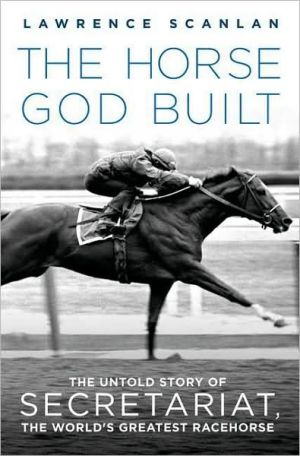Seabiscuit: An American Legend
Seabiscuit was an unlikely champion: a roughhewn, undersized horse with a sad little tail and knees that wouldn't straighten all the way. But, thanks to the efforts of three men, Seabiscuit became one of the most spectacular performers in sports history. The rags-to-riches horse emerged as an American cultural icon, drawing an immense following and becoming the single biggest newsmaker of 1938 -- receiving more coverage than FDR or Hitler. Laura Hillenbrand beautifully renders this story of...
Search in google:
Seabiscuit: An American Legend is the ultimate underdog story. New York Times - Jim Squires [T]he story of this ragged-tailed racehorse [is] an allegory for Depression-era America. . . . [Hillenbrand's book] is a flawless trip, with the detail of good history . . . and the charm of grand legend.
Chapter One: The Day of the Horse is Past\ Charles Howard had the feel of a gigantic onrushing machine: You had to either climb on or leap out of the way. He would sweep into a room, working a cigarette in his fingers, and people would trail him like pilot fish. They couldn't help themselves. Fifty-eight years old in 1935, Howard was a tall, glowing man in a big suit and a very big Buick. But it wasn't his physical bearing that did it. He lived on a California ranch so huge that a man could take a wrong turn on it and be lost forever, but it wasn't his circumstances either. Nor was it that he spoke loud or long; the surprise of the man was his understatement, the quiet and kindly intimacy of his acquaintance. What drew people to him was something intangible, an air about him. There was a certain inevitability to Charles Howard, an urgency radiating from him that made people believe that the world was always going to bend to his wishes.\ On an afternoon in 1903, long before the big cars and the ranch and all the money, Howard began his adulthood with only that air of destiny and 21 cents in his pocket. He sat in the swaying belly of a transcontinental train, snaking west from New York. He was twenty-six, handsome, gentlemanly, with a bounding imagination. Back then he had a lot more hair than anyone who knew him later would have guessed. Years in the saddles of military-school horses had taught him to carry his six-foot-one-inch frame straight up. He was eastern born and bred, but he had a westerner's restlessness. He had tried to satisfy it by enlisting in the cavalry for the Spanish-American War, and though he became a skilled horseman, thanks to bad timing and dysentery he never got out of Camp Wheeler in Alabama. After his discharge, he got a job in New York as a bicycle mechanic, took up competitive bicycle racing, got married, and had two sons. It seems to have been a good life, but the East stifled Howard. His mind never seemed to settle down. His ambitions had fixed upon the vast new America on the other side of the Rockies. That day in 1903 he couldn't resist the impulse anymore. He left everything he'd ever known behind, promised his wife Fannie May he'd send for her soon, and got on the train.\ He got off in San Francisco. His two dimes and a penny couldn't carry him far, but somehow he begged and borrowed enough money to open a little bicycle-repair shop on Van Ness Avenue downtown. He tinkered with the bikes and waited for something interesting to come his way.\ It came in the form of a string of distressed-looking men who began appearing at his door.\ Eccentric souls with too much money in their pockets and far too much time on their hands, they had blown thick wads of cash on preposterous machines called automobiles. Some of them were feeling terribly sorry about it.\ The horseless carriage was just arriving in San Francisco, and its debut was turning into one of those colorfully unmitigated disasters that bring misery to everyone but historians. Consumers were staying away from the "devilish contraptions" in droves. The men who had invested in them were the subjects of cautionary tales, derision, and a fair measure of public loathing. In San Francisco in 1903, the horse and buggy was not going the way of the horse and buggy.\ For good reason. The automobile, so sleekly efficient on paper, was in practice a civic menace, belching out exhaust, kicking up storms of dust, becoming hopelessly mired in the most innocuous-looking puddles, tying up horse traffic, and raising an earsplitting cacophony that sent buggy horses fleeing. Incensed local lawmakers responded with monuments to legislative creativity. The laws of at least one town required automobile drivers to stop, get out, and fire off Roman candles every time horse-drawn vehicles came into view. Massachusetts tried and, fortunately, failed to mandate that cars be equipped with bells that would ring with each revolution of the wheels. In some towns police were authorized to disable passing cars with ropes, chains, wires, and even bullets, so long as they took reasonable care to avoid gunning down the drivers. San Francisco didn't escape the legislative wave. Bitter local officials pushed through an ordinance banning automobiles from the Stanford campus and all tourist areas, effectively exiling them from the city.\ Nor were these the only obstacles. The asking price for the cheapest automobile amounted to twice the $500 annual salary of the average citizen‹some cost three times that much‹and all that bought you was four wheels, a body, and an engine. "Accessories" like bumpers, carburetors, and headlights had to be purchased separately. Just starting the thing, through hand cranking, could land a man in traction. With no gas stations, owners had to lug five-gallon fuel cans to local drugstores, filling them for 60 cents a gallon and hoping the pharmacist wouldn't substitute benzene for gasoline. Doctors warned women away from automobiles, fearing slow suffocation in noxious fumes. A few adventurous members of the gentler sex took to wearing ridiculous "windshield hats," watermelon-sized fabric balloons, equipped with little glass windows, that fit over the entire head, leaving ample room for corpulent Victorian coiffures. Navigation was another nightmare. The first of San Francisco's road signs were only just being erected, hammered up by an enterprising insurance underwriter who hoped to win clients by posting directions into the countryside, whose drivers retreated for automobile "picnic parties" held out of the view of angry townsfolk.\ Finally, driving itself was something of a touch-and-go pursuit. The first automobiles imported to San Francisco had so little power that they rarely made it up the hills. The grade of Nineteenth Avenue was so daunting for the engines of the day that watching automobiles straining for the top became a local pastime. The automobiles' delicate constitutions and general faintheartedness soon became a source of scorn. One cartoon from the era depicted a wealthy couple standing on a roadside next to its dearly departed vehicle. The caption read, "The Idle Rich."...
Preface11Part I1.The Day of the Horse Is Past172.The Lone Plainsman413.Mean, Restive, and Ragged584.The Cougar and the Iceman835.A Boot on One Foot, a Toe Tag on the Other1066.Light and Shadow131Part II7.Learn Your Horse1538.Fifteen Strides1729.Gravity19210.War Admiral21211.No Pollard, No Seabiscuit23312.All I Need Is Luck25813.Hardball27714.The Wise We Boys29815.Fortune's Fool32316.I Know My Horse33817.The Dingbustingest Contest You Ever Clapped an Eye On35118.Deal36619.The Second Civil War384Part III20."All Four of His Legs Are Broken"40721.A Long, Hard Pull42522.Four Good Legs Between Us43423.One Hundred Grand452Epilogue467Acknowledgments484Notes497
\ From Barnes & NobleBarnes & Noble Discover Great New Writers\ What, you may ask, is a biography of a famous race horse doing in the Discover program? Well, if you take a look at Seabiscuit -- a good look -- you'll understand. Much as Sebastian Junger did in The Perfect Storm, Laura Hillenbrand has woven together the many strands of lives that improbably create a phenomenon -- in this case, no raging storm, but legendary racing history. The little horse, Seabiscuit, with his crooked legs and sad tail, was at first thought lazy, but with the help of a trinity of men -- his trainer, his owner, and a jockey -- would make racing history and find a place in the hearts of thousands of fans in Depression-era America. Laura Hillenbrand has done what only great writers can do: She has taken a story that in other, less capable hands would be fodder strictly for the racing crowd, and written as dramatic and informative a biography of a horse and of 1938 America as you'll find. When you read this book, an America mired in the Depression and searching for something to believe in comes alive. The faith of those Americans in the little horse with heart will awaken your own, and when you read Seabiscuit's racing scenes, even the most skeptical reader will find themselves jumping up and down, shouting at Seabiscuit to "Run!"\ \ \ \ \ Jim Squires[T]he story of this ragged-tailed racehorse [is] an allegory for Depression-era America. . . . [Hillenbrand's book] is a flawless trip, with the detail of good history . . . and the charm of grand legend.\ — New York Times\ \ \ Mark HymanHillenbrand, a contributing writer at Equus magazine, is a deft storyteller whose descriptions of such races are especially good, filled with images of pounding hooves and splattering mud. \ — Business Week\ \ \ \ \ Deirdre DonahueSeabiscuit brings alive the drama, the beauty, the louche charm and the brutality of horse racing. Hillenbrand makes the reader understand why Americans, crushed by the Depression, found so much hope, inspiration and pleasure in the story of a small horse who rose from obscurity to become a champion. \ — USA Today\ \ \ \ \ Publishers WeeklyGifted sportswriter Hillenbrand unearths the rarefied world of thoroughbred horse racing in this captivating account of one of the sport's legends. Though no longer a household name, Seabiscuit enjoyed great celebrity during the 1930s and 1940s, drawing record crowds to his races around the country. Not an overtly impressive physical specimen--"His stubby legs were a study in unsound construction, with huge, squarish, asymmetrical `baseball glove' knees that didn't quite straighten all the way"--the horse seemed to transcend his physicality as he won race after race. Hillenbrand, a contributor to Equus magazine, profiles the major players in Seabiscuit's fantastic and improbable career. In simple, elegant prose, she recounts how Charles Howard, a pioneer in automobile sales and Seabiscuit's eventual owner, became involved with horse racing, starting as a hobbyist and growing into a fanatic. She introduces esoteric recluse Tom Smith (Seabiscuit's trainer) and jockey Red Pollard, a down-on-his-luck rider whose specialty was taming unruly horses. In 1936, Howard united Smith, Pollard and "The Biscuit," whose performance had been spotty--and the horse's star career began. Smith, who recognized Seabiscuit's potential, felt an immediate rapport with him and eased him into shape. Once Seabiscuit started breaking records and outrunning lead horses, reporters thronged the Howard barn day and night. Smith's secret workouts became legendary and only heightened Seabiscuit's mystique. Hillenbrand deftly blends the story with explanations of the sport and its culture, including vivid descriptions of the Tijuana horse-racing scene in all its debauchery. She roots her narrative of the horse's breathtaking career and the wild devotion of his fans in its socioeconomic context: Seabiscuit embodied the underdog myth for a nation recovering from dire economic straits. Copyright 2000 Cahners Business Information.\ \ \ \ \ Library JournalA veteran thoroughbred-racing writer whose stories have appeared in American Heritage, Talk, and other magazines, Hillenbrand here takes readers on a thrilling ride through 341 pages on the back of champion thoroughbred Seabiscuit. This is a Cinderella story in which four creatures, united for a brief period of time (1936-47), spark the imagination of an entire country. Hillenbrand combines the horse's biography with a social history of 1930s and 1940s America and incisive portraits of the team around Seabiscuit. Charlie Howard, a car dealer, bought the crooked-legged, scruffy little horse; Tom Smith, a man who rarely spoke to people but who communicated perfectly with horses, became its trainer; and Red Pollard, a half-blind jockey, rode Seabiscuit to fame. Hillenbrand's extensive research compares favorably with that of Alexander MacKay-Smith's in Speed and the Thoroughbred (Derrydale, 2000). This story of trust, optimism, and perseverance in overcoming obstacles will appeal to many readers. Highly recommended. [Previewed in Prepub Alert, LJ 11/1/00.] Patsy E. Gray, Huntsville P.L., AL Copyright 2001 Cahners Business Information.\ \ \ \ \ School Library JournalThis well-written and compelling book celebrates the life of a racehorse that just happened to be a descendant of Man O' War. It is a story of a huge talent that almost went unrecognized until the right people came along. According to descriptions, Seabiscuit was a runt, with stubby legs, an odd walk, and a lazy nature. However, he became so popular that he drew more news coverage than President Roosevelt, Hitler, or Mussolini. The atmosphere surrounding his historic match with War Admiral was so intense that FDR kept advisors waiting as he listened with the rest of the country to hear the outcome. Hillenbrand also tells the stories of owner Charles Howard, trainer Tom Smith, and jockey Red Pollard and the part each man played in the recognition and development of a racing legend. But the book is much more. Seabiscuit is a story of the times and it is a story of the hard and dangerous life of a jockey. Even readers with no interest in the sport will be hooked with the opening sentence of the book's preface. Hillenbrand does a wonderful job in bringing an unlikely winner to life.-Peggy Bercher, Fairfax County Public Library, VA Copyright 2001 Cahners Business Information.\ \ \ \ \ Kirkus ReviewsThe former editor of Equus magazine retells the riveting story of an unlikely racehorse that became an American obsession during the Depression. Like all heroes of an epic, Seabiscuit had to endure setbacks, dispel doubts about his abilities, and contend with formidable rivals. Hillenbrand deftly mixes arcane horse lore with a narrative as compelling as any adventure yarn as she introduces first the men who would make Seabiscuit great and then the horse himself. Racing was a popular, often unregulated sport in the 1930s, and wealthy men like Bing Crosby and his friend Charles Howard, who became Seabiscuit's owner, fielded strings of horses all over the country. Howard, a sucker for lost causes, took on as his trainer Tom Smith, a taciturn westerner down on his luck who studied horses for days until he took their measure. Both men were well suited to invest emotionally and financially in Seabiscuit, as were the two jockeys who would be associated with him, Red Pollard and George Woolf. Howard first saw Seabiscuit racing in 1936. The colt was a descendant of the famous Man o' War, but his body was stunted, his legs stubby, and he walked with an odd gait. Smith believed he had potential, however, so Howard bought him and took him back to California. There Smith patiently worked on Seabiscuit's strengths, corrected his weaknesses, and encouraged his ability to run faster than any other horse. When Smith thought he was ready, Howard began racing the colt. Seabiscuit broke numerous track records, despite accidents, injuries, and even foul play. His fame was secured with a 1938 race against his rival, War Admiral; their contest divided the country into two camps and garnered more media coverage than President Roosevelt, who himself was so riveted by the race that he kept advisers waiting while he listened to the broadcast. A great ride.\ \ \ \ \ From the Publisher“Fascinating . . . Vivid . . . A first-rate piece of storytelling, leaving us not only with a vivid portrait of a horse but a fascinating slice of American history as well.”\ –The New York Times\ \ “Engrossing . . . Fast-moving . . . More than just a horse’s tale, because the humans who owned, trained, and rode Seabiscuit are equally fascinating. . . . [Hillenbrand] shows an extraordinary talent for describing a horse race so vividly that the reader feels like the rider.” \ –Sports Illustrated\ “REMARKABLE . . . MEMORABLE . . . JUST AS COMPELLING TODAY AS IT WAS IN 1938.”\ –The Washington Post\ \ \
